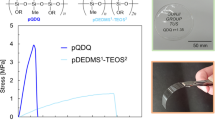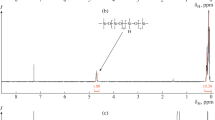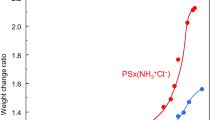Abstract
Polysiloxanes were prepared by acid-catalyzed controlled hydrolytic co-polycondensation of polymethyl(methoxy)siloxanes (PMS) and polymethoxysiloxanes (PMOS) obtained as macromonomers by acid-catalyzed controlled hydrolytic polycondensation of methyl(trimethoxy)silane and tetramethoxysilane, respectively. Co-polycondensation of the macromonomers with molecular weights M w 2000 (PMS) and 400 (PMOS) provided polymethylsiloxane copolymers with molecular weights M w 6500–15,000. The structure was confirmed to consist of block copolymers poly(PMS-block-PMOS) based on the results of gel permeation chromatography, isolation by fractional precipitation with THF and hexane, and 1H and 29Si NMR spectral analyses. The copolymers were soluble in organic solvents, except for hexane, and were fairly stable to self-condensation even without an end block. Transparent and flexible free-standing films were obtained from a 20 wt% THF solution of polymers. The surface morphology of films by FE-SEM and IR microscopic spectral analyses revealed cross-shaped crystalline materials on the film surface of poly(PMS-block-PMOS); these materials consisted of silsesquioxane unit structures depending on the compositions of PMS and PMOS.
Graphical Abstract
Polysiloxanes were prepared by acid-catalyzed controlled hydrolytic co-polycondensation of polymethyl(methoxy)siloxanes (PMS) and polymethoxysiloxanes (PMOS). The structure was confirmed to consist of block copolymers poly(PMS-block-PMOS). The surface morphology of transparent and flexible free-standing films revealed cross-shaped crystalline materials on the film surface of poly(PMS-block-PMOS); these materials consisted of silsesquioxane unit structures depending on the compositions of PMS and PMOS.










Similar content being viewed by others
References
Brus J, Skrdlantova M (2001) 1H MAS NMR study of structure of hybrid siloxane-based networks and the interaction with quartz filler. J Non-Crystal Solids 281:61–71
Pedroso M, Dias M, Azuma C, San Gil R, Mothe C (2003) Hydrocarbon dispersion of nanospherical silica by a sol–gel process. 2. Alkoxysilane copolymerization. Col Polym Sci 281:19–26
Pang YX, Hodgson SNB, Weglinski B, Gaworska D (2006) Investigations into sol-gel silica and silica hybrid coatings for dielectromagnetic soft magnetic composite applications. J Mat Sci 41:5926–5936
Fyfe CA, Aroca PP, Zhang Y (1993) NMR characterization of the homopolymers and copolymers formed from tetraethoxysilane and methytriethoxysilane in a sol-gel process. Bull Mag Reson 15:195–198
Prabakar S, Assink RA (1997) Hydrolysis and condensation kinetics of two component organically modified silica sols. J Non-Crystal Solids 211:39–48
Dire S, Pagani E, Babonneau F, Ceccato R, Carturan G (1997) Unsupported SiO2-based organic–inorganicmembranes. J Mat Chem 7:67–73
Yu S, Wong TKS, Hu X, Yong MS (2005) Dielectric and mechanical properties of surface modified organosilicate films. J Sol-Gel Sci Tech 35:69–75
Wang S, Fan X, Si Q, Kong J, Liu Y, Qiao W, Zhang G (2006) Preparation and characterization of a hyperbranched polyethoxysiloxane based anti-fouling coating. J Appl Polym Sci 102:5818–5824
Takamura N, Gunji T, Hatano H, Abe Y (1999) Preparation and properties of polysilsesquioxanes: polysilsesquioxanes and flexible thin films by acid-catalyzed controlled hydrolytic polycondensation of methyl- and vinyltrimethoxysilane. J Polym Sci, Part A: Polym Chem 37:1017–1026
Gunji T, Okonogi H, Sakan T, Takamura N, Arimitsu K, Abe Y (2003) Preparation and properties of organic-inorganic hybrid gel films based on polyvinylsilsesquioxane synthesized from trimethoxy(vinyl)silane. Appl Organomet Chem 17:580–588
Abe Y, Honda Y, Gunji T (1998) Preparation and properties of silicon-containing polymer hybrids from 3-methacryloxypropyltrimethoxysilane. Appl Organomet Chem 12:749–753
Gunji T, Makabe Y, Takamura N, Abe Y (2001) Preparation and characterization of organic-inorganic hybrids and coating films from 3-methacryloxypropylpolysilsesquioxane. Appl Organomet Chem 15:683–692
Gunji T, Shigematsu Y, Abe Y, Fujita S, Inagaki S (2007) Preparation of free-standing films from 3-mercaptopropylpolysilsesquioxane. Kobunshi Ronbunshu 64:705–707
Gunji T, Shigematsu Y, Kajiwara T, Abe Y (2010) Preparation of free-standing films with sulfonyl group from 3-mercaptopropyl(trimethoxy)silane/1,2-bis(triethoxysilyl)ethane copolymer. Polym J 42:684–688
Abe Y, Shimano R, Arimitsu K, Gunji T (2003) Preparation and properties of high molecular weight polyethoxysiloxanes stable to self-condensation by acid-catalyzed hydrolytic polycondensation of tetraethoxysilane. J Polym Sci, Part A: Polym Chem 41:2250–2255
Gunji T, Hayashi H, Komatsubara A, Arimitsu K, Abe Y (2012) Preparation and properties of flexible free-standing films via polyalkoxysiloxanes by acid-catalyzed controlled hydrolytic polycondensation of tetraethoxysilane and tetramethoxysilane. Appl Organomet Chem 26:32–36
Gunji T, Tozune T, Kaburaki H, Arimitsu K, Abe Y (2013) Preparation of co-polymethyl(alkoxy)siloxanes by acid-catalyzed controlled hydrolytic copolycondensation of methyl(trialkoxy)silane and tetraalkoxysilane. J Polym Sci Polym Chem 51:4732–4741
Acknowledgments
This work was supported by a Grant-in-Aid for Scientific Research on Innovative Areas “New Polymeric Materials Based on Element-Blocks (no. 2401)” (24102008A02) from the Ministry of Education, Culture, Sports, Science, and Technology, Japan.
Author information
Authors and Affiliations
Corresponding author
Rights and permissions
About this article
Cite this article
Gunji, T., Kaburagi, H., Tsukada, S. et al. Preparation, properties, and structure of polysiloxanes by acid-catalyzed controlled hydrolytic co-polycondensation of polymethyl(methoxy)siloxane and polymethoxysiloxane. J Sol-Gel Sci Technol 75, 564–573 (2015). https://doi.org/10.1007/s10971-015-3727-z
Received:
Accepted:
Published:
Issue Date:
DOI: https://doi.org/10.1007/s10971-015-3727-z




